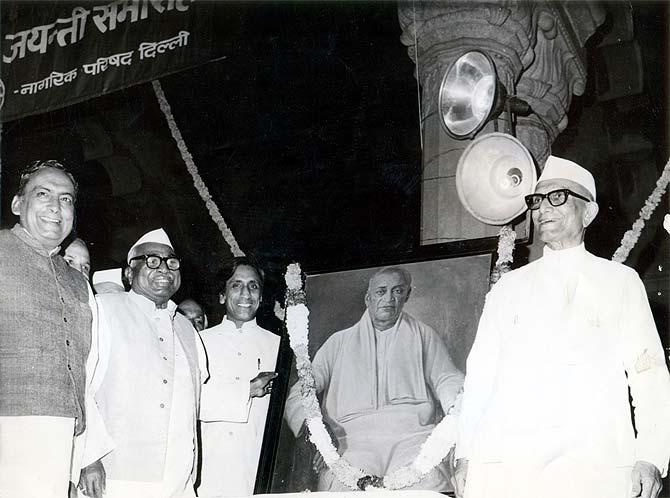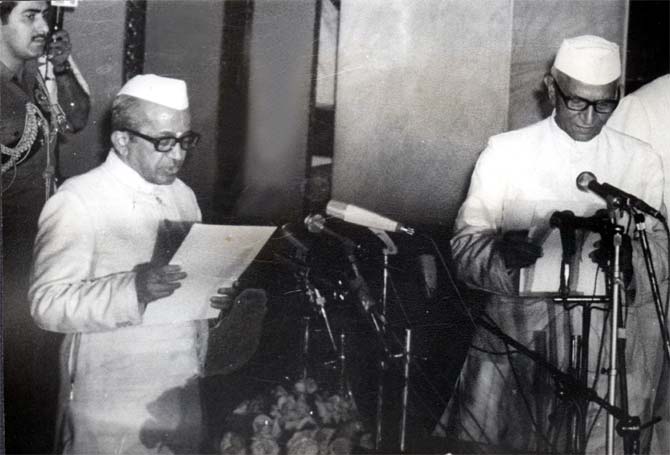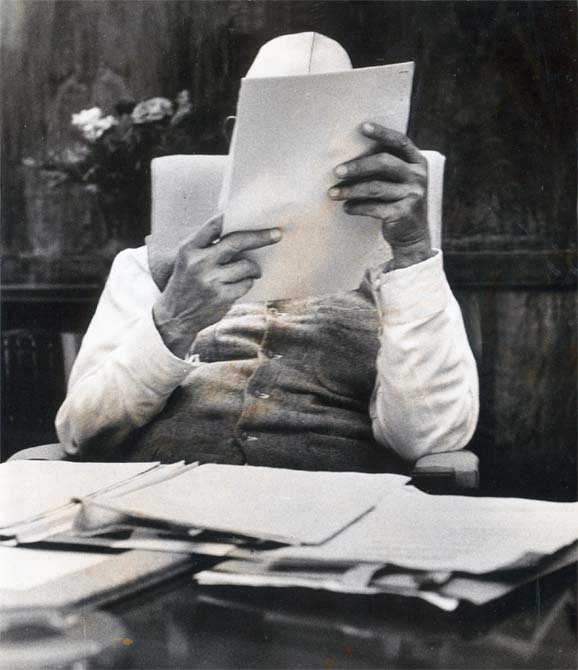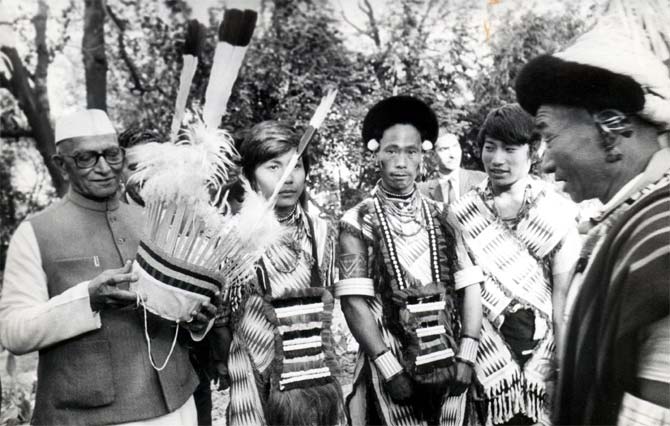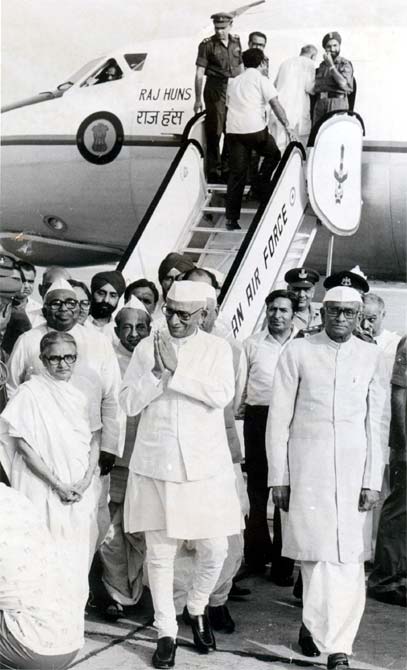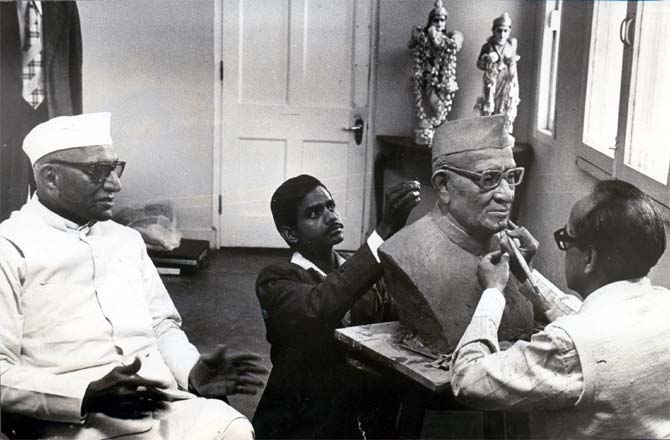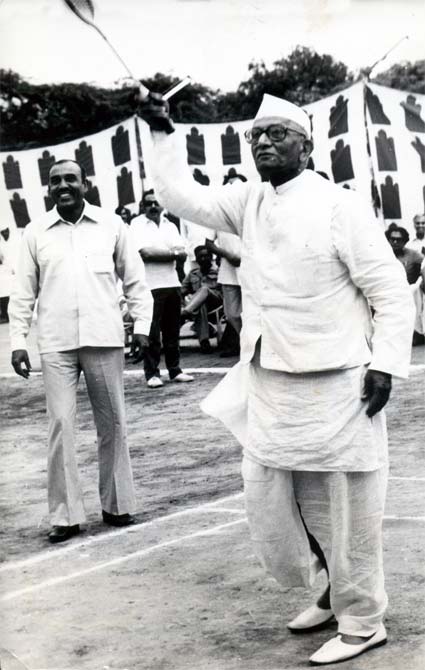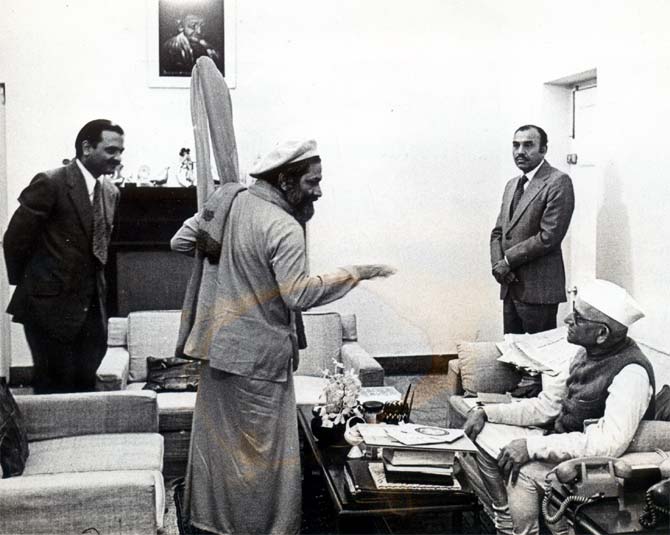 | « Back to article | Print this article |
Before Modi, there was Morarjibhai
If Narendra Modi becomes prime minister next month, he will be India's second prime minister from the western state of Gujarat.
Thirty-seven years ago, Morarji Desai was sworn in as India's first non-Congress prime minister, indeed the oldest man at 81 to then hold the office.
Morajibhai headed the Janata Party government, which was elected to power after the 19-month state of Emergency ended and which saw the country vote resoundingly against then prime minister Indira Gandhi and her Congress-Ruling party.
The Congress-R could win only two seats in North India, Indira Gandhi and her younger son Sanjay Gandhi were both defeated. The party fared much better in South India, but lost power to the Janata Party which was constituted by the Congress-Organisation, Bharatiya Jana Sangh, Bharatiya Lok Dal and Congress for Democracy.
In the early 1960s, Desai, then a stalwart of the Congress party, had tried to become prime minister, both after Jawaharlal Nehru and his successor Lal Bahadur Shastri's deaths.
A puritan if there was one, Morarjibhai had to settle for deputy prime minister and finance minister in Indira Gandhi's government before she replaced him, just before she split the Congress party into the Congress-R under her command and the Congress-O led by veteran Congressmen Desai, K Kamaraj, S Nijalingappa, S K Patil and Atulya Ghosh.
Imprisoned during the Emergency, despite his age, along with others like Jayaprakash Narayan, Atal Bihari Vajpayee and L K Advani, Desai was the near unanimous choice to be prime minister since JP -- who had headed the movement against corruption (sounds familiar?) in 1974 and 1975 against Indira Gandhi's government -- was not interested in power.
Alas! Morarjibhai had only two years to savour his life-long dream.
Internal conflicts -- between members of the Jana Sangh like Vajpayee and Advani, who refused to renounce their allegiance to the Rashtriya Swayamsevak Sangh, and other Janata Party leaders; and the almost never-ending rebellion mounted by then home minister Chaudhary Charan Singh and his Sancho Panza Raj Narain against Desai and the Janata Party organisation -- pulverised the Janata Party.
In July 1979, Desai lost majority support in the Janata Party and resigned as prime minister.
In the slides that follow, we present a brief glimpse of Morarji Desai's time in office. Photographs produced from the India Abroad -- the oldest and best-known Indian-American newsweekly owned by Rediff.com -- archives.
Kindly click Next to see more...
Before Modi, there was Morarjibhai
Morarji Desai was sworn in as prime minister by acting President B D Jatti, the first and only time an Indian prime minister has been sworn in by an acting Head of State.
President Fakhruddin Ali Ahmed, who signed the proclamation of Emergency on June 25, 1975, had died in January 1977. Vice-President Jatti, a politician from Karnataka, took over as the acting President till a new President was elected in July 1977.
The new President was Neelam Sanjeeva Reddy, who as the official Congress candidate had lost the 1969 Presidential election to Vice-President V V Giri, provoking the split in the Congress party.
The 1969 election too was caused by the death of a President -- Dr Zakir Hussain -- in office.
Kindly click Next to see more...
Before Modi, there was Morarjibhai
Prime Minister Morarji Desai with senior Cabinet ministers and Opposition leaders in Parliament house, June 18, 1977.
To Desai's right are Home Minister Chaudhary Charan Singh, Defence Minister Babu Jagjivan Ram and Information and Broadcasting Minister L K Advani.
Opposite Desai in a Gandhi topi is Y B Chavan, the legendary Maharashtra politician.
Jagjivan Ram, who did not care much for Lal Bahadur Shastri, had backed Morarji Desai's candidature for prime minister after Jawaharlal Nehru's death in May 1964.
That campaign fizzled out after Desai and his supporters realised that Shastri enjoyed greater support in the Congress Parliamentary Party.
Both Desai and Chavan were chief ministers of the undivided Bombay state. Of course, Desai, Jagjivan Ram and Chavan all served in the Nehru, Shastri and Indira Gandhi Cabinets of the 1960s.
Kindly click Next to see more...
Before Modi, there was Morarjibhai
Morarji Desai was considered a superb administrator who had more than 60 years of experience across government portfolios before he became prime minister.
Even though he had a stubborn, no nonsense, reputation, Desai was one of the handful of prime ministers in the last 40 years who read government files cover to cover and had a mastery of their brief.
India would likely have been a very different country had Morarjibhai enjoyed a full term in office.
The Punjab problem may, for instance, never have occurred, fuelled as it was by Indira Gandhi's games to neuralise the Akalis.
India's institutions, which were damaged by Indira Gandhi's meddling in the mid 1970s, may have also been restored to their grandeur, rather than be undermined again after she returned to power in January 1980.
Kindly click Next to see more...
Before Modi, there was Morarjibhai
Four of the five men in this photograph were prime ministers.
Morarji Desai, the man with his back to the camera.
Chaudhary Charan Singh, to Desai's right, succeeded him and remains the only prime minister not to win a vote of confidence.
Chaudharysaab resigned before he could face Parliament after Indira Gandhi and her Congress party withdrew support to his government.
An early election may not have been called and Indira Gandhi may not have returned to power had then President Neelam Sanjeeva Reddy given Babu Jagjivan Ram, the longest-serving minister in Independent India and current Lok Sabha Speaker Meira Kumar's father, time to prove his majority in the House.
After first giving Babuji time to do so, Reddy abruptly changed his mind and dissolved Parliament.
It was unbecoming of the President and remains fully unexplained to this day.
Babuji, who is at the centre of the photograph, is the only person among this quintet not to be prime minister.
Chandra Shekhar, to Desai's left, was then the powerful president of the Janata Party and became prime minister for a few months, with Congress support, in 1990-1991.
Atal Bihari Vajpayee, external affairs minister in the Desai Cabinet, flanked here by Chaudhary Charan Singh and Babu Jagjivan Ram, was thrice prime minister of India, in 1996, in 1998 and 1999.
Kindly click Next to see more...
Before Modi, there was Morarjibhai
Long before Narendra Modi wore stylish head gear from the North-East, Morarji Desai was spotted with a Naga hat on January 27, 1978.
Morajibhai was seldom seen without his Gandhi topi during his days in politics and government and unlike Narendrabhai, he would not part with his cap even for a colourful Naga one.
Kindly click Next to see more...
Before Modi, there was Morarjibhai
Morarji Desai is the only Indian prime minister to survive an air crash.
His aircraft crashed in Jorhat, Assam, on November 4, 1977, but the prime minister, tough as nails even though he was three months short of 82, escaped without injury.
When he returned to New Delhi from Tezpur on November 5, 1977, President Neelam Sanjiva Reddy and Vice-President B D Jatti set aside protocol to receive the prime minister at Palam airport.
Kindly click Next to see more...
Before Modi, there was Morarjibhai
Jawaharlal Nehru did so more than any other prime minister in Independent India's history -- address the nation from the ramparts of the Red Fort on the occasion of Independence Day.
His successor Lal Bahadur Shastri did it twice before he died prematurely in Tashkent on a bleak January day in 1966.
Indira Gandhi, Nehru's daughter, addressed the nation 10 times from the Red Fort before this scene: The first non Congress prime minister speaking to India from the historic 17th fort on what was a milestone in the nation's history, its 30th Independence Day.
Will Narendra Modi become the second Gujarati prime minister to do so this August?
Kindly click Next to see more...
Before Modi, there was Morarjibhai
Three scenes coming up which one rarely sees with our leaders, let alone prime ministers, these days.
Morarji Desai watches as finishing touches are given to a bust of the prime minister by sculptor G M Kolhatkar.
Kindly click Next to see more...
Before Modi, there was Morarjibhai
When was the last time you saw a prime minister play sport?
Prime Minister Morarji Desai inaugurates a badminton tournament for Members of Parliament, May 14, 1979.
Please note: Morarjibhai was two months past his 83rd birthday (he was born February 29, 1896) that day.
Kindly click Next to see more...
Before Modi, there was Morarjibhai
A sadhu at a prime minister's home?
Security men keep watch as a sadhu calls on Prime Minister Morarji Desai at his New Delhi home.
